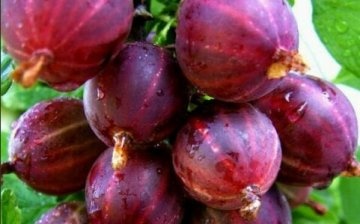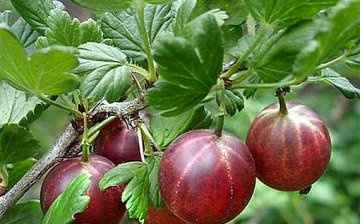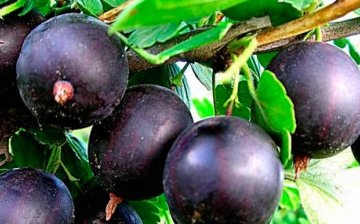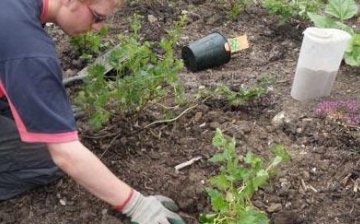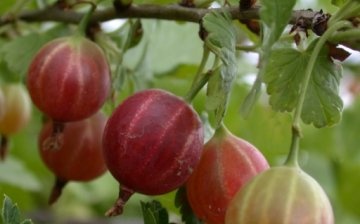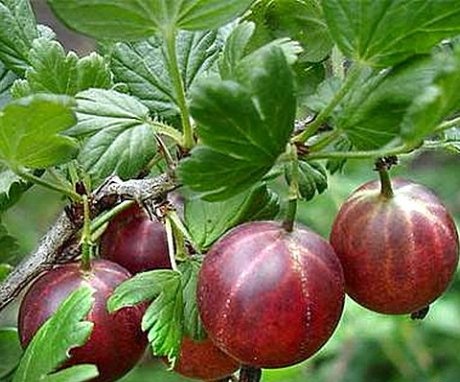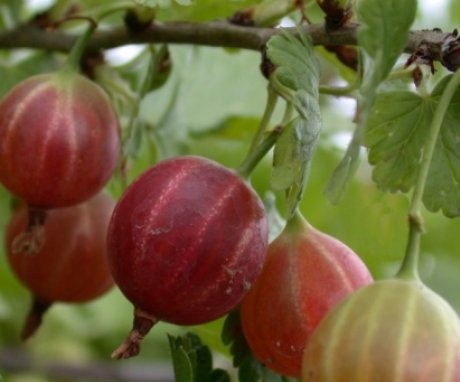Thornless gooseberries: care and features of varieties
Gooseberry is one of the popular horticultural crops. Its fruits are tasty both fresh and canned. But bush care and harvesting are complicated by unpleasant thorns. If you like healthy juicy berries, but do not want to scratch and prick when picking them, then you may need to pay attention to the thornless gooseberry, bred on the basis of North American varieties.
Content:
- Features of the studless gooseberry
- Common thornless varieties
- Planting a studless gooseberry
- Rules for the care of thornless gooseberry varieties
Features of the studless gooseberry
If you decide to start growing a thornless gooseberry, then do not forget that a bush completely devoid of thorns has not yet been bred. The branches will have thorniness, but much weaker than that of older varieties. The fact is that thorns can disappear or appear on any gooseberry bushes. It all depends on the age or the characteristics of the care. For example, the seedlings of the slightly thorny variety "Northern Captain" are dotted with needles, which fall off almost completely by the beginning of fruiting, while the branches of "Vladil" are covered with thorns only on old bushes.
Gardeners argue about gustatory qualities of gooseberries thornless. Proponents of new varieties claim that they yield sweeter berries. Opponents claim that the fruits of the "prickly" gooseberry are much tastier.
Much depends on individual preferences, but note that the taste of the berries is not related to the degree of prickly, but is determined by the variety.
Gardeners are often faced with powdery mildew (or spheroteka), the fight against it is difficult and may even be useless, the affected plants have to be cut down. It is enough to pour hot water (80 ° C) on the bushes of the bushless gooseberry in the spring and forget about this misfortune forever. In addition, an important advantage is its resistance to diseases, which often affect European, strongly spiny species.
Common thornless varieties
Since gooseberries have been cultivated for more than one century, several dozen varieties with reduced thorniness have been bred.
The most common in Russian conditions are the following:
- Eaglet. High-yielding early ripening variety, practically without thorns. Black sweet and sour berries are suitable for all types of canning.
- Gingerbread man. This popular variety is loved by gardeners for its resistance to pests, fast growth, large and early ripening fruits. But Kolobok also has noticeable disadvantages: the cherry-colored berries, although they are quite pleasant to the taste, still do not have a bright aroma, and maintenance requires constant pruning and attention to sudden changes in temperature.
- Legin the studless. It is a low-spiked medium-late ripening variety, frost-resistant. The berries are pear-shaped, dark red, large, sour-sweet. Contains a lot of vitamin C.
- Malachite. High-yielding, unpretentious variety. Thorns are rare, but evenly scattered throughout the branch. The delicate pulp, covered with a thin skin, has a somewhat unusual taste, therefore, jams are often made from berries and compotes are prepared.
- African. Lush bushes with sparse thorns, medium-ripening berries of a purple hue.They taste like currants; various jellies are often prepared from them.
- Ural besshorny. Frost-resistant variety, resistant to pests and diseases... Begins to bear fruit in the second or third year. Large light green berries have a sweet, slightly sour taste, are eaten fresh, and are also used for various winter preparations.
Planting a studless gooseberry
Planting new bushes should be done from late September to mid-October, it is important to choose high-quality planting material... A hole of 40x40x40 cm is dug, a bucket of well-rotted manure is added to it, up to a kilogram of complex mineral fertilizers, 2-3 tbsp. spoons of wood ash. All this is thoroughly mixed and after that the seedling is lowered into the hole.
Mulching should be carried out a day after planting and watering, which will help retain moisture in the soil and reduce the number of weeding.
Chopped pine bark, peat, etc. are used as mulch. In the first year, you will not need to feed the plant, but only if the planting was done correctly.
In the second year, a young shrub in early spring is necessary feed with manure diluted with water (1: 8). In the third year, fertilizer is applied with the following composition: 6 kg of manure, half a glass of wood ash, 20 g of superphosphate per square meter of soil. In the future, it is enough to fertilize once every two to three years, not forgetting about the nitrogenous feeding of the fruit-bearing bushes after the snow melts.
Rules for caring for studless varieties
Regardless of the selected varieties, all shrubs require carehowever, thornless gooseberry varieties give the owner a minimum of hassle. This type of gooseberry has a high yield, and it is easier to grow it, because the shoots do not prick when pruned, treated against pests, etc.
There are some general rules to follow when caring for common varieties:
- The soil should be weeded and loosened regularly, in conditions of heat and lack of rain, water at the rate of one bucket under a bush for newly planted plants and three or four for fruit bearing ones.
- Stop watering before harvesting! This is a mandatory rule, otherwise, the berries will acquire a sour taste.
- For bushes to produce maximum yield, you must do formative pruning. The next year after planting, the (zero) shoots growing from the soil are cut out, leaving several (4-5) most developed ones; in subsequent years, no more than five strongest shoots are also left. The greatest yield can be obtained from 4-6 year old branches.
- Older shoots must be removed, as well as stunted, diseased, small branches that thicken the growth of the bush. An adult bush should have 10-14 different-aged branches (not older than 7 years), then it will bear fruit well.
- At the age of 10 years, pruning for the purpose of rejuvenation is recommended, carried out in late autumn: all branches are cut to ground level, except for young shoots.
In autumn, phosphorus-potassium fertilizers are applied to the soil, this additionally increases the frost resistance of the gooseberry.
If simple care is carried out correctly, gooseberry bushes will bear fruit for up to 30-40 years, delighting with tasty and healthy berries, which have a strengthening, anti-sclerotic, anti-inflammatory effect. And which variety to choose is up to you.
More information can be found in the video.



